Conflict Resolution Report: Communication Approaches and Action Plan
VerifiedAdded on 2023/01/19
|10
|2926
|28
Report
AI Summary
This report provides a comprehensive analysis of conflict resolution strategies within an organizational context. It begins by defining conflict resolution and emphasizing the importance of effective communication, negotiation, and transparency. The main body identifies and examines various theoretical communication approaches and methods, including oral, written, and non-verbal communication, illustrating their application through a case study involving employee conflict. The report also explores the use of groupware technology to overcome communication barriers. Furthermore, it outlines a suitable action plan for conflict management, addressing interpersonal, organizational, change-related, and external sources of conflict. The report highlights the importance of communication and active listening in resolving disputes and fostering a positive work environment. The report provides practical recommendations for conflict resolution and organizational improvement.
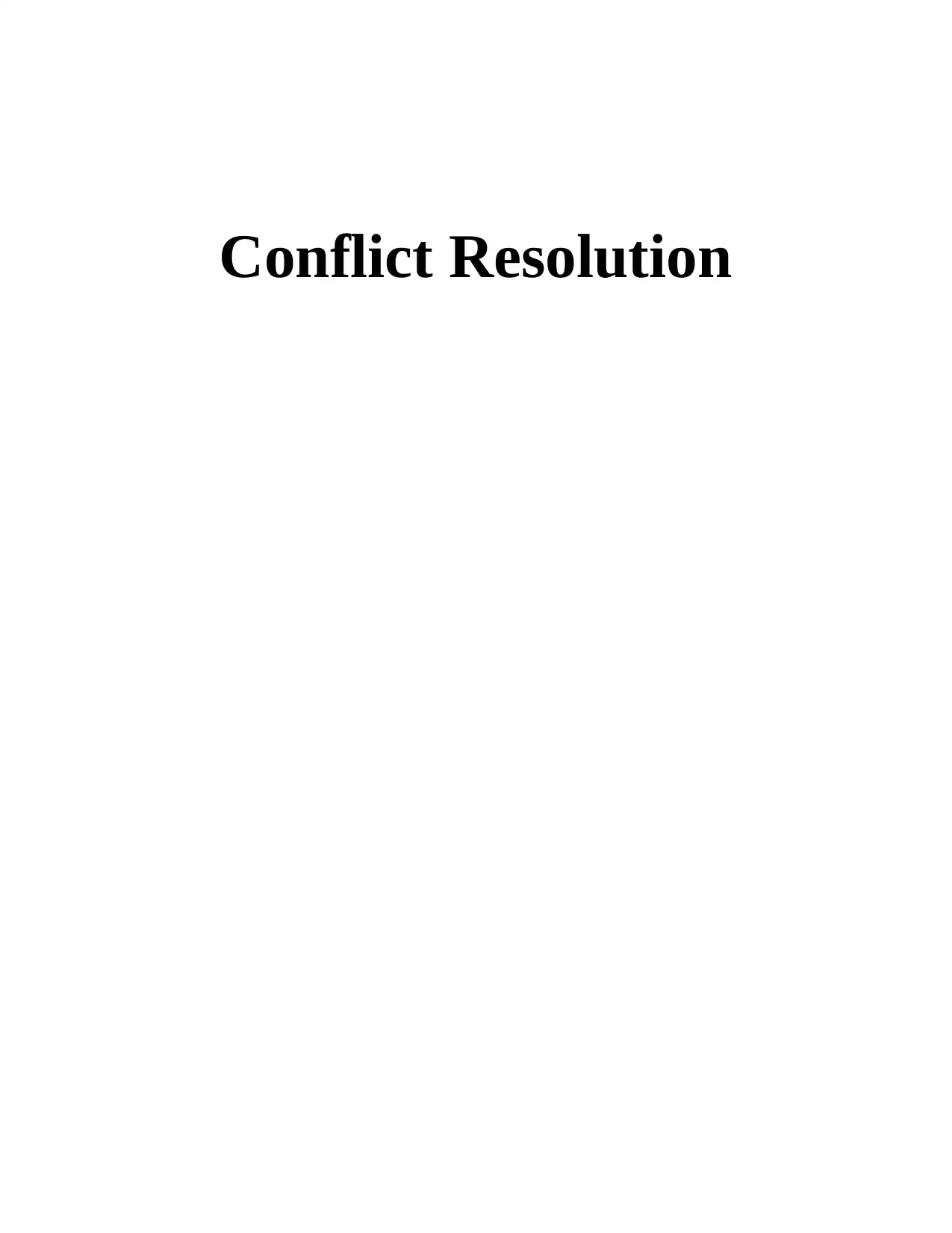
Conflict Resolution
Paraphrase This Document
Need a fresh take? Get an instant paraphrase of this document with our AI Paraphraser
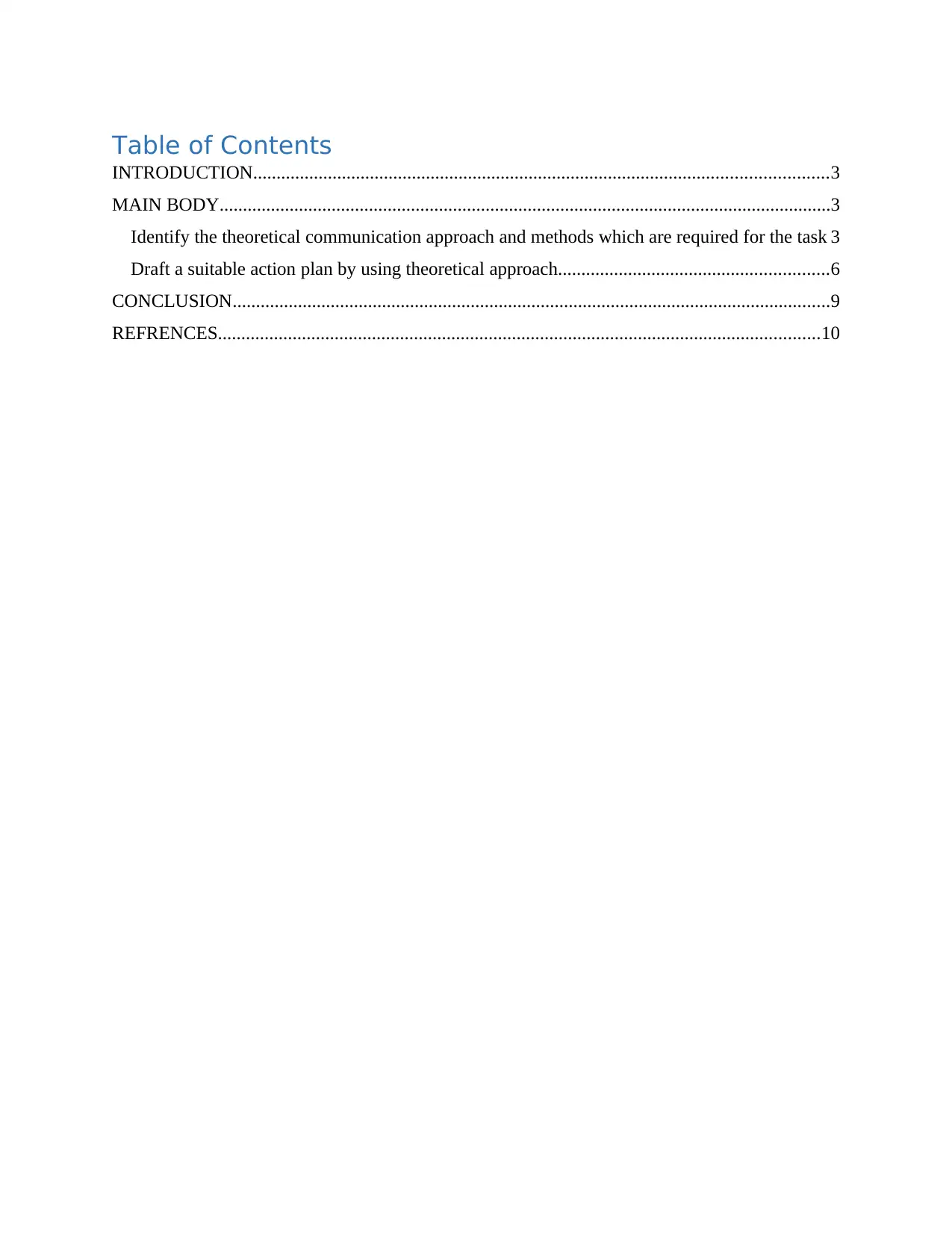
Table of Contents
INTRODUCTION...........................................................................................................................3
MAIN BODY...................................................................................................................................3
Identify the theoretical communication approach and methods which are required for the task 3
Draft a suitable action plan by using theoretical approach..........................................................6
CONCLUSION................................................................................................................................9
REFRENCES.................................................................................................................................10
INTRODUCTION...........................................................................................................................3
MAIN BODY...................................................................................................................................3
Identify the theoretical communication approach and methods which are required for the task 3
Draft a suitable action plan by using theoretical approach..........................................................6
CONCLUSION................................................................................................................................9
REFRENCES.................................................................................................................................10
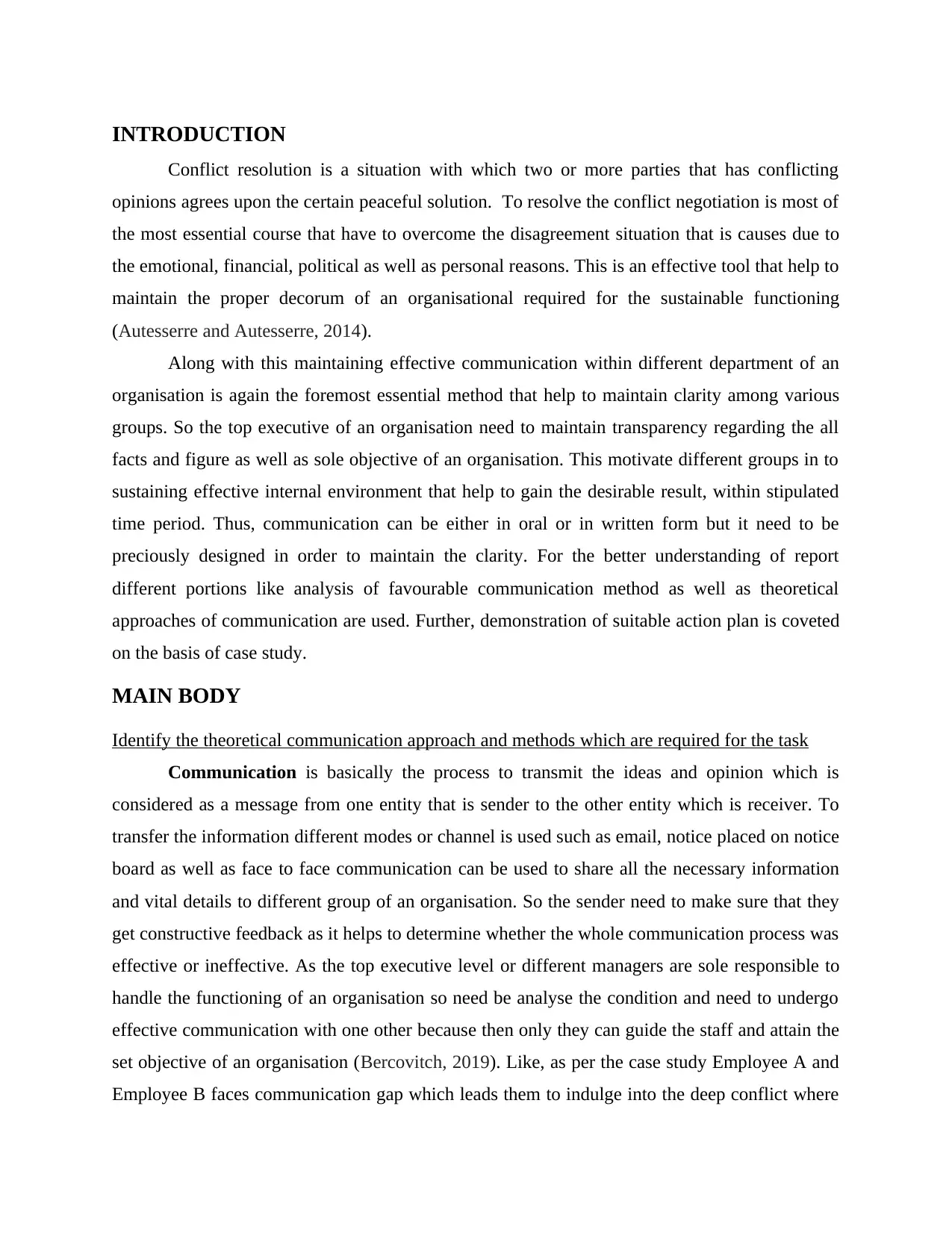
INTRODUCTION
Conflict resolution is a situation with which two or more parties that has conflicting
opinions agrees upon the certain peaceful solution. To resolve the conflict negotiation is most of
the most essential course that have to overcome the disagreement situation that is causes due to
the emotional, financial, political as well as personal reasons. This is an effective tool that help to
maintain the proper decorum of an organisational required for the sustainable functioning
(Autesserre and Autesserre, 2014).
Along with this maintaining effective communication within different department of an
organisation is again the foremost essential method that help to maintain clarity among various
groups. So the top executive of an organisation need to maintain transparency regarding the all
facts and figure as well as sole objective of an organisation. This motivate different groups in to
sustaining effective internal environment that help to gain the desirable result, within stipulated
time period. Thus, communication can be either in oral or in written form but it need to be
preciously designed in order to maintain the clarity. For the better understanding of report
different portions like analysis of favourable communication method as well as theoretical
approaches of communication are used. Further, demonstration of suitable action plan is coveted
on the basis of case study.
MAIN BODY
Identify the theoretical communication approach and methods which are required for the task
Communication is basically the process to transmit the ideas and opinion which is
considered as a message from one entity that is sender to the other entity which is receiver. To
transfer the information different modes or channel is used such as email, notice placed on notice
board as well as face to face communication can be used to share all the necessary information
and vital details to different group of an organisation. So the sender need to make sure that they
get constructive feedback as it helps to determine whether the whole communication process was
effective or ineffective. As the top executive level or different managers are sole responsible to
handle the functioning of an organisation so need be analyse the condition and need to undergo
effective communication with one other because then only they can guide the staff and attain the
set objective of an organisation (Bercovitch, 2019). Like, as per the case study Employee A and
Employee B faces communication gap which leads them to indulge into the deep conflict where
Conflict resolution is a situation with which two or more parties that has conflicting
opinions agrees upon the certain peaceful solution. To resolve the conflict negotiation is most of
the most essential course that have to overcome the disagreement situation that is causes due to
the emotional, financial, political as well as personal reasons. This is an effective tool that help to
maintain the proper decorum of an organisational required for the sustainable functioning
(Autesserre and Autesserre, 2014).
Along with this maintaining effective communication within different department of an
organisation is again the foremost essential method that help to maintain clarity among various
groups. So the top executive of an organisation need to maintain transparency regarding the all
facts and figure as well as sole objective of an organisation. This motivate different groups in to
sustaining effective internal environment that help to gain the desirable result, within stipulated
time period. Thus, communication can be either in oral or in written form but it need to be
preciously designed in order to maintain the clarity. For the better understanding of report
different portions like analysis of favourable communication method as well as theoretical
approaches of communication are used. Further, demonstration of suitable action plan is coveted
on the basis of case study.
MAIN BODY
Identify the theoretical communication approach and methods which are required for the task
Communication is basically the process to transmit the ideas and opinion which is
considered as a message from one entity that is sender to the other entity which is receiver. To
transfer the information different modes or channel is used such as email, notice placed on notice
board as well as face to face communication can be used to share all the necessary information
and vital details to different group of an organisation. So the sender need to make sure that they
get constructive feedback as it helps to determine whether the whole communication process was
effective or ineffective. As the top executive level or different managers are sole responsible to
handle the functioning of an organisation so need be analyse the condition and need to undergo
effective communication with one other because then only they can guide the staff and attain the
set objective of an organisation (Bercovitch, 2019). Like, as per the case study Employee A and
Employee B faces communication gap which leads them to indulge into the deep conflict where
⊘ This is a preview!⊘
Do you want full access?
Subscribe today to unlock all pages.

Trusted by 1+ million students worldwide
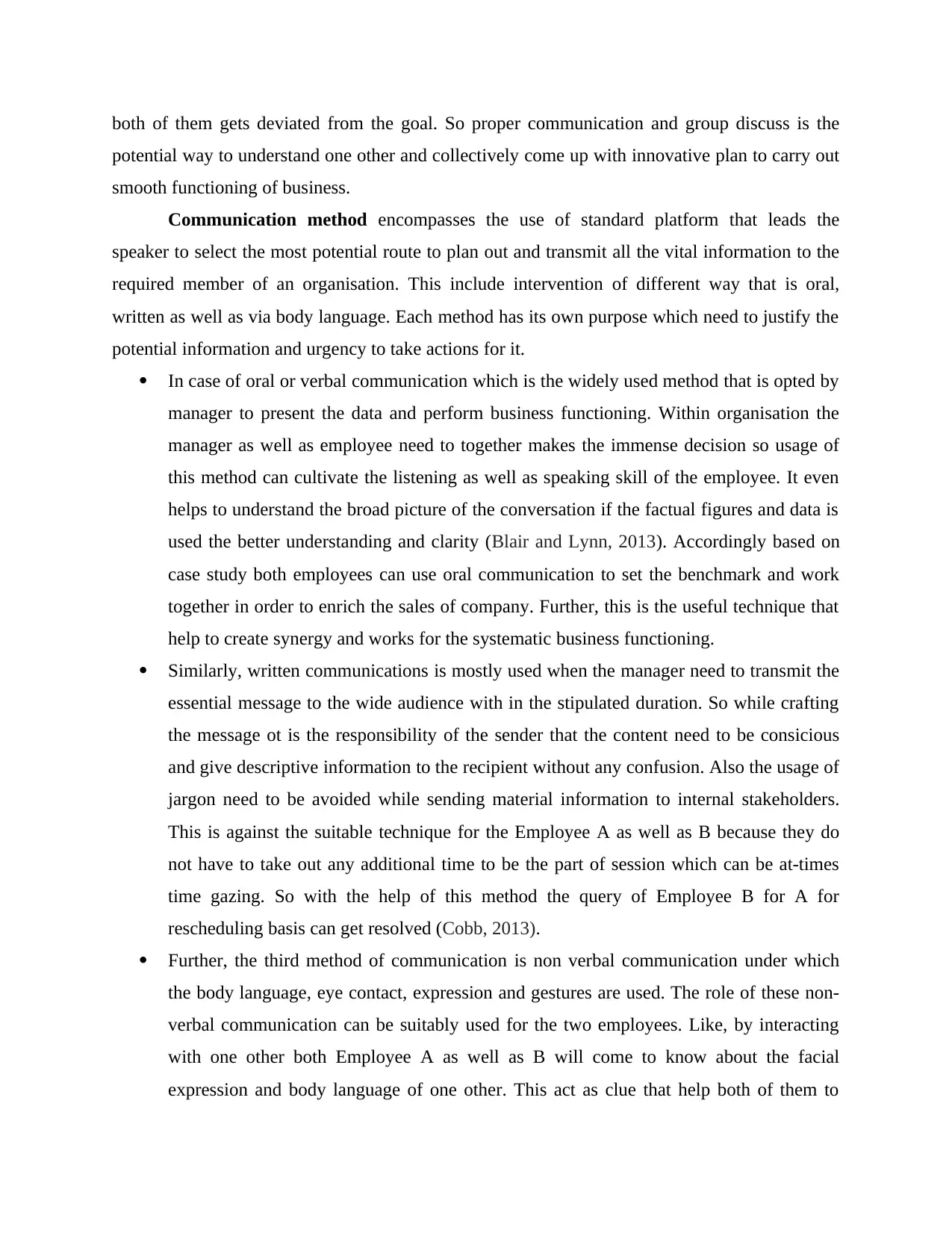
both of them gets deviated from the goal. So proper communication and group discuss is the
potential way to understand one other and collectively come up with innovative plan to carry out
smooth functioning of business.
Communication method encompasses the use of standard platform that leads the
speaker to select the most potential route to plan out and transmit all the vital information to the
required member of an organisation. This include intervention of different way that is oral,
written as well as via body language. Each method has its own purpose which need to justify the
potential information and urgency to take actions for it.
In case of oral or verbal communication which is the widely used method that is opted by
manager to present the data and perform business functioning. Within organisation the
manager as well as employee need to together makes the immense decision so usage of
this method can cultivate the listening as well as speaking skill of the employee. It even
helps to understand the broad picture of the conversation if the factual figures and data is
used the better understanding and clarity (Blair and Lynn, 2013). Accordingly based on
case study both employees can use oral communication to set the benchmark and work
together in order to enrich the sales of company. Further, this is the useful technique that
help to create synergy and works for the systematic business functioning.
Similarly, written communications is mostly used when the manager need to transmit the
essential message to the wide audience with in the stipulated duration. So while crafting
the message ot is the responsibility of the sender that the content need to be consicious
and give descriptive information to the recipient without any confusion. Also the usage of
jargon need to be avoided while sending material information to internal stakeholders.
This is against the suitable technique for the Employee A as well as B because they do
not have to take out any additional time to be the part of session which can be at-times
time gazing. So with the help of this method the query of Employee B for A for
rescheduling basis can get resolved (Cobb, 2013).
Further, the third method of communication is non verbal communication under which
the body language, eye contact, expression and gestures are used. The role of these non-
verbal communication can be suitably used for the two employees. Like, by interacting
with one other both Employee A as well as B will come to know about the facial
expression and body language of one other. This act as clue that help both of them to
potential way to understand one other and collectively come up with innovative plan to carry out
smooth functioning of business.
Communication method encompasses the use of standard platform that leads the
speaker to select the most potential route to plan out and transmit all the vital information to the
required member of an organisation. This include intervention of different way that is oral,
written as well as via body language. Each method has its own purpose which need to justify the
potential information and urgency to take actions for it.
In case of oral or verbal communication which is the widely used method that is opted by
manager to present the data and perform business functioning. Within organisation the
manager as well as employee need to together makes the immense decision so usage of
this method can cultivate the listening as well as speaking skill of the employee. It even
helps to understand the broad picture of the conversation if the factual figures and data is
used the better understanding and clarity (Blair and Lynn, 2013). Accordingly based on
case study both employees can use oral communication to set the benchmark and work
together in order to enrich the sales of company. Further, this is the useful technique that
help to create synergy and works for the systematic business functioning.
Similarly, written communications is mostly used when the manager need to transmit the
essential message to the wide audience with in the stipulated duration. So while crafting
the message ot is the responsibility of the sender that the content need to be consicious
and give descriptive information to the recipient without any confusion. Also the usage of
jargon need to be avoided while sending material information to internal stakeholders.
This is against the suitable technique for the Employee A as well as B because they do
not have to take out any additional time to be the part of session which can be at-times
time gazing. So with the help of this method the query of Employee B for A for
rescheduling basis can get resolved (Cobb, 2013).
Further, the third method of communication is non verbal communication under which
the body language, eye contact, expression and gestures are used. The role of these non-
verbal communication can be suitably used for the two employees. Like, by interacting
with one other both Employee A as well as B will come to know about the facial
expression and body language of one other. This act as clue that help both of them to
Paraphrase This Document
Need a fresh take? Get an instant paraphrase of this document with our AI Paraphraser
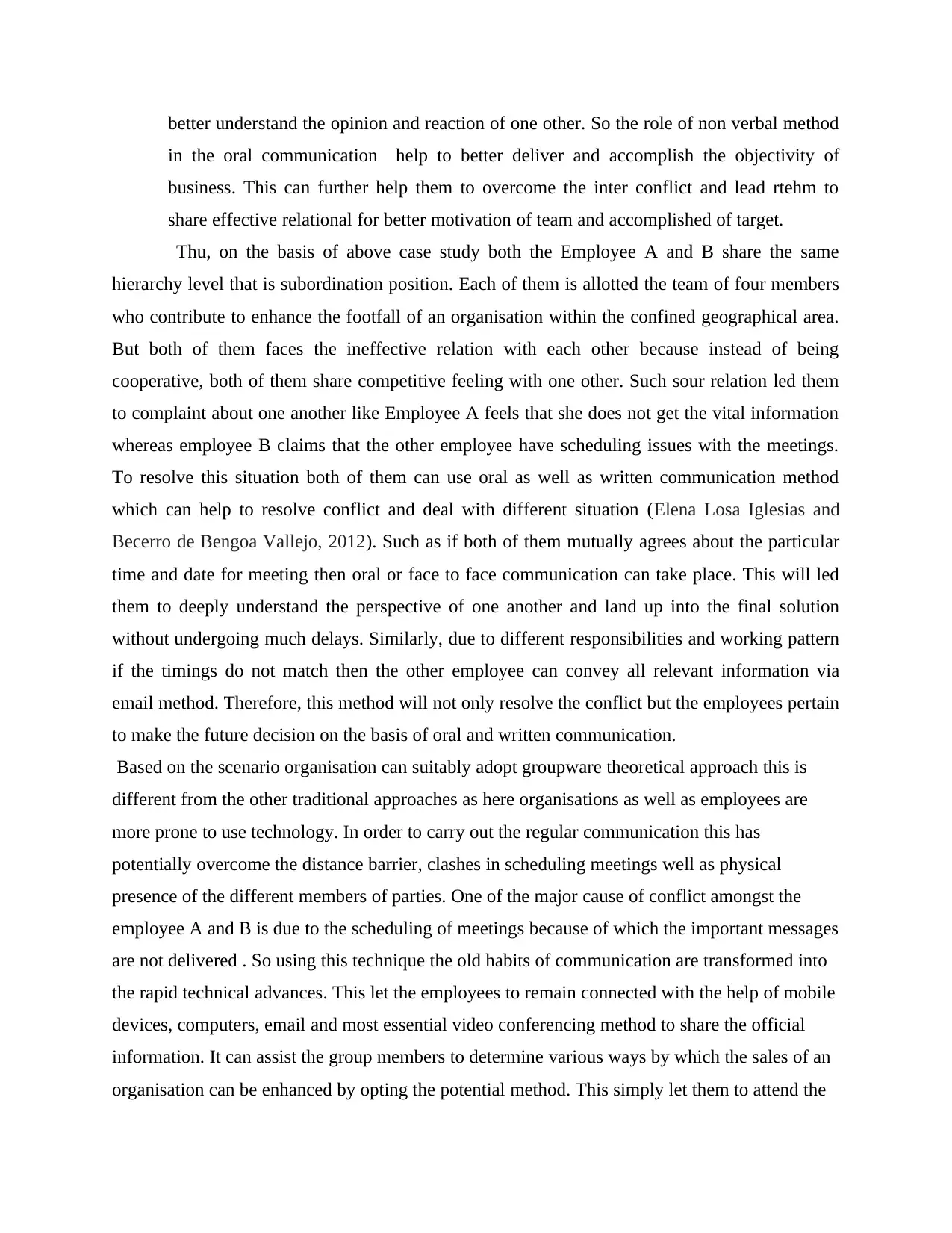
better understand the opinion and reaction of one other. So the role of non verbal method
in the oral communication help to better deliver and accomplish the objectivity of
business. This can further help them to overcome the inter conflict and lead rtehm to
share effective relational for better motivation of team and accomplished of target.
Thu, on the basis of above case study both the Employee A and B share the same
hierarchy level that is subordination position. Each of them is allotted the team of four members
who contribute to enhance the footfall of an organisation within the confined geographical area.
But both of them faces the ineffective relation with each other because instead of being
cooperative, both of them share competitive feeling with one other. Such sour relation led them
to complaint about one another like Employee A feels that she does not get the vital information
whereas employee B claims that the other employee have scheduling issues with the meetings.
To resolve this situation both of them can use oral as well as written communication method
which can help to resolve conflict and deal with different situation (Elena Losa Iglesias and
Becerro de Bengoa Vallejo, 2012). Such as if both of them mutually agrees about the particular
time and date for meeting then oral or face to face communication can take place. This will led
them to deeply understand the perspective of one another and land up into the final solution
without undergoing much delays. Similarly, due to different responsibilities and working pattern
if the timings do not match then the other employee can convey all relevant information via
email method. Therefore, this method will not only resolve the conflict but the employees pertain
to make the future decision on the basis of oral and written communication.
Based on the scenario organisation can suitably adopt groupware theoretical approach this is
different from the other traditional approaches as here organisations as well as employees are
more prone to use technology. In order to carry out the regular communication this has
potentially overcome the distance barrier, clashes in scheduling meetings well as physical
presence of the different members of parties. One of the major cause of conflict amongst the
employee A and B is due to the scheduling of meetings because of which the important messages
are not delivered . So using this technique the old habits of communication are transformed into
the rapid technical advances. This let the employees to remain connected with the help of mobile
devices, computers, email and most essential video conferencing method to share the official
information. It can assist the group members to determine various ways by which the sales of an
organisation can be enhanced by opting the potential method. This simply let them to attend the
in the oral communication help to better deliver and accomplish the objectivity of
business. This can further help them to overcome the inter conflict and lead rtehm to
share effective relational for better motivation of team and accomplished of target.
Thu, on the basis of above case study both the Employee A and B share the same
hierarchy level that is subordination position. Each of them is allotted the team of four members
who contribute to enhance the footfall of an organisation within the confined geographical area.
But both of them faces the ineffective relation with each other because instead of being
cooperative, both of them share competitive feeling with one other. Such sour relation led them
to complaint about one another like Employee A feels that she does not get the vital information
whereas employee B claims that the other employee have scheduling issues with the meetings.
To resolve this situation both of them can use oral as well as written communication method
which can help to resolve conflict and deal with different situation (Elena Losa Iglesias and
Becerro de Bengoa Vallejo, 2012). Such as if both of them mutually agrees about the particular
time and date for meeting then oral or face to face communication can take place. This will led
them to deeply understand the perspective of one another and land up into the final solution
without undergoing much delays. Similarly, due to different responsibilities and working pattern
if the timings do not match then the other employee can convey all relevant information via
email method. Therefore, this method will not only resolve the conflict but the employees pertain
to make the future decision on the basis of oral and written communication.
Based on the scenario organisation can suitably adopt groupware theoretical approach this is
different from the other traditional approaches as here organisations as well as employees are
more prone to use technology. In order to carry out the regular communication this has
potentially overcome the distance barrier, clashes in scheduling meetings well as physical
presence of the different members of parties. One of the major cause of conflict amongst the
employee A and B is due to the scheduling of meetings because of which the important messages
are not delivered . So using this technique the old habits of communication are transformed into
the rapid technical advances. This let the employees to remain connected with the help of mobile
devices, computers, email and most essential video conferencing method to share the official
information. It can assist the group members to determine various ways by which the sales of an
organisation can be enhanced by opting the potential method. This simply let them to attend the
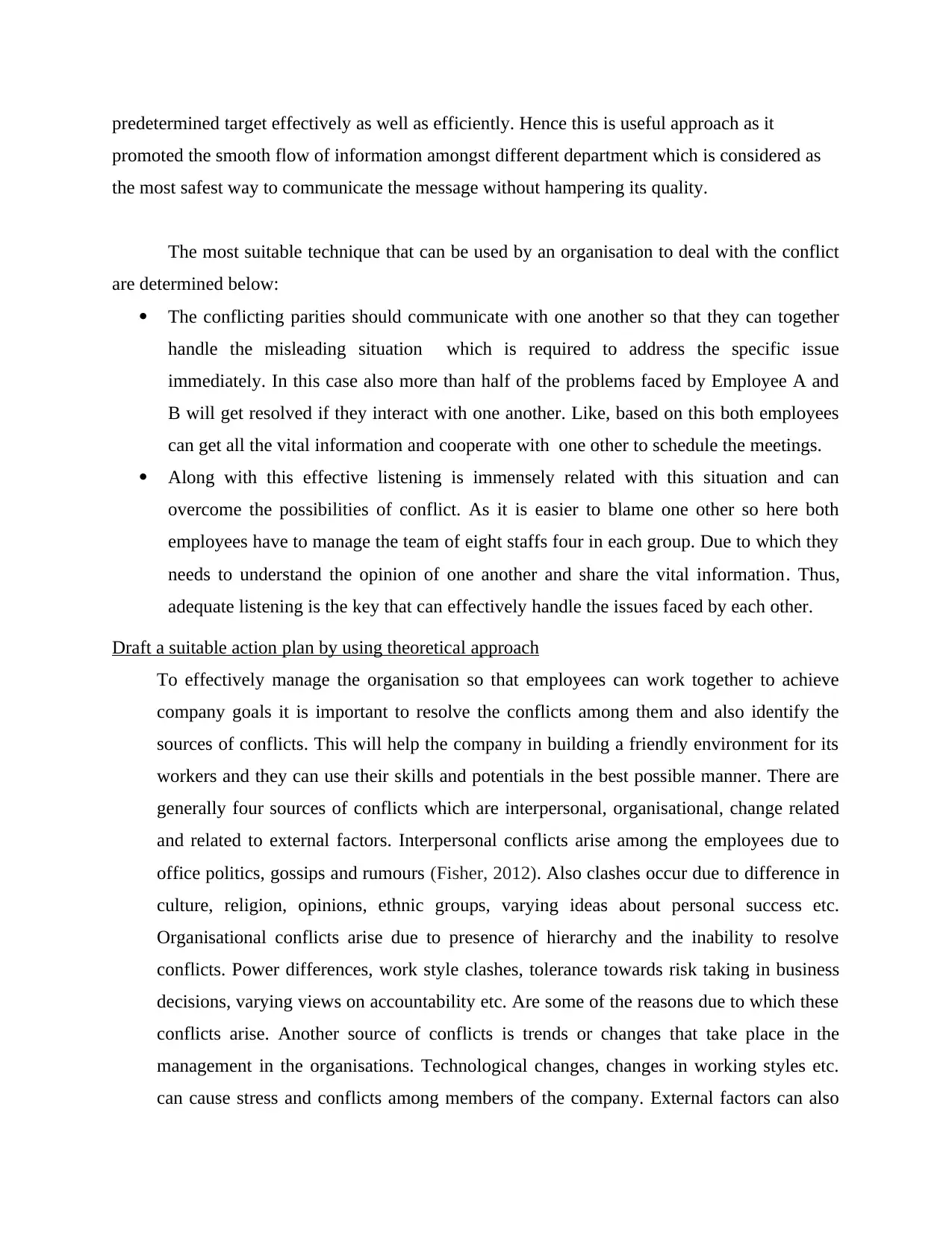
predetermined target effectively as well as efficiently. Hence this is useful approach as it
promoted the smooth flow of information amongst different department which is considered as
the most safest way to communicate the message without hampering its quality.
The most suitable technique that can be used by an organisation to deal with the conflict
are determined below:
The conflicting parities should communicate with one another so that they can together
handle the misleading situation which is required to address the specific issue
immediately. In this case also more than half of the problems faced by Employee A and
B will get resolved if they interact with one another. Like, based on this both employees
can get all the vital information and cooperate with one other to schedule the meetings.
Along with this effective listening is immensely related with this situation and can
overcome the possibilities of conflict. As it is easier to blame one other so here both
employees have to manage the team of eight staffs four in each group. Due to which they
needs to understand the opinion of one another and share the vital information. Thus,
adequate listening is the key that can effectively handle the issues faced by each other.
Draft a suitable action plan by using theoretical approach
To effectively manage the organisation so that employees can work together to achieve
company goals it is important to resolve the conflicts among them and also identify the
sources of conflicts. This will help the company in building a friendly environment for its
workers and they can use their skills and potentials in the best possible manner. There are
generally four sources of conflicts which are interpersonal, organisational, change related
and related to external factors. Interpersonal conflicts arise among the employees due to
office politics, gossips and rumours (Fisher, 2012). Also clashes occur due to difference in
culture, religion, opinions, ethnic groups, varying ideas about personal success etc.
Organisational conflicts arise due to presence of hierarchy and the inability to resolve
conflicts. Power differences, work style clashes, tolerance towards risk taking in business
decisions, varying views on accountability etc. Are some of the reasons due to which these
conflicts arise. Another source of conflicts is trends or changes that take place in the
management in the organisations. Technological changes, changes in working styles etc.
can cause stress and conflicts among members of the company. External factors can also
promoted the smooth flow of information amongst different department which is considered as
the most safest way to communicate the message without hampering its quality.
The most suitable technique that can be used by an organisation to deal with the conflict
are determined below:
The conflicting parities should communicate with one another so that they can together
handle the misleading situation which is required to address the specific issue
immediately. In this case also more than half of the problems faced by Employee A and
B will get resolved if they interact with one another. Like, based on this both employees
can get all the vital information and cooperate with one other to schedule the meetings.
Along with this effective listening is immensely related with this situation and can
overcome the possibilities of conflict. As it is easier to blame one other so here both
employees have to manage the team of eight staffs four in each group. Due to which they
needs to understand the opinion of one another and share the vital information. Thus,
adequate listening is the key that can effectively handle the issues faced by each other.
Draft a suitable action plan by using theoretical approach
To effectively manage the organisation so that employees can work together to achieve
company goals it is important to resolve the conflicts among them and also identify the
sources of conflicts. This will help the company in building a friendly environment for its
workers and they can use their skills and potentials in the best possible manner. There are
generally four sources of conflicts which are interpersonal, organisational, change related
and related to external factors. Interpersonal conflicts arise among the employees due to
office politics, gossips and rumours (Fisher, 2012). Also clashes occur due to difference in
culture, religion, opinions, ethnic groups, varying ideas about personal success etc.
Organisational conflicts arise due to presence of hierarchy and the inability to resolve
conflicts. Power differences, work style clashes, tolerance towards risk taking in business
decisions, varying views on accountability etc. Are some of the reasons due to which these
conflicts arise. Another source of conflicts is trends or changes that take place in the
management in the organisations. Technological changes, changes in working styles etc.
can cause stress and conflicts among members of the company. External factors can also
⊘ This is a preview!⊘
Do you want full access?
Subscribe today to unlock all pages.

Trusted by 1+ million students worldwide
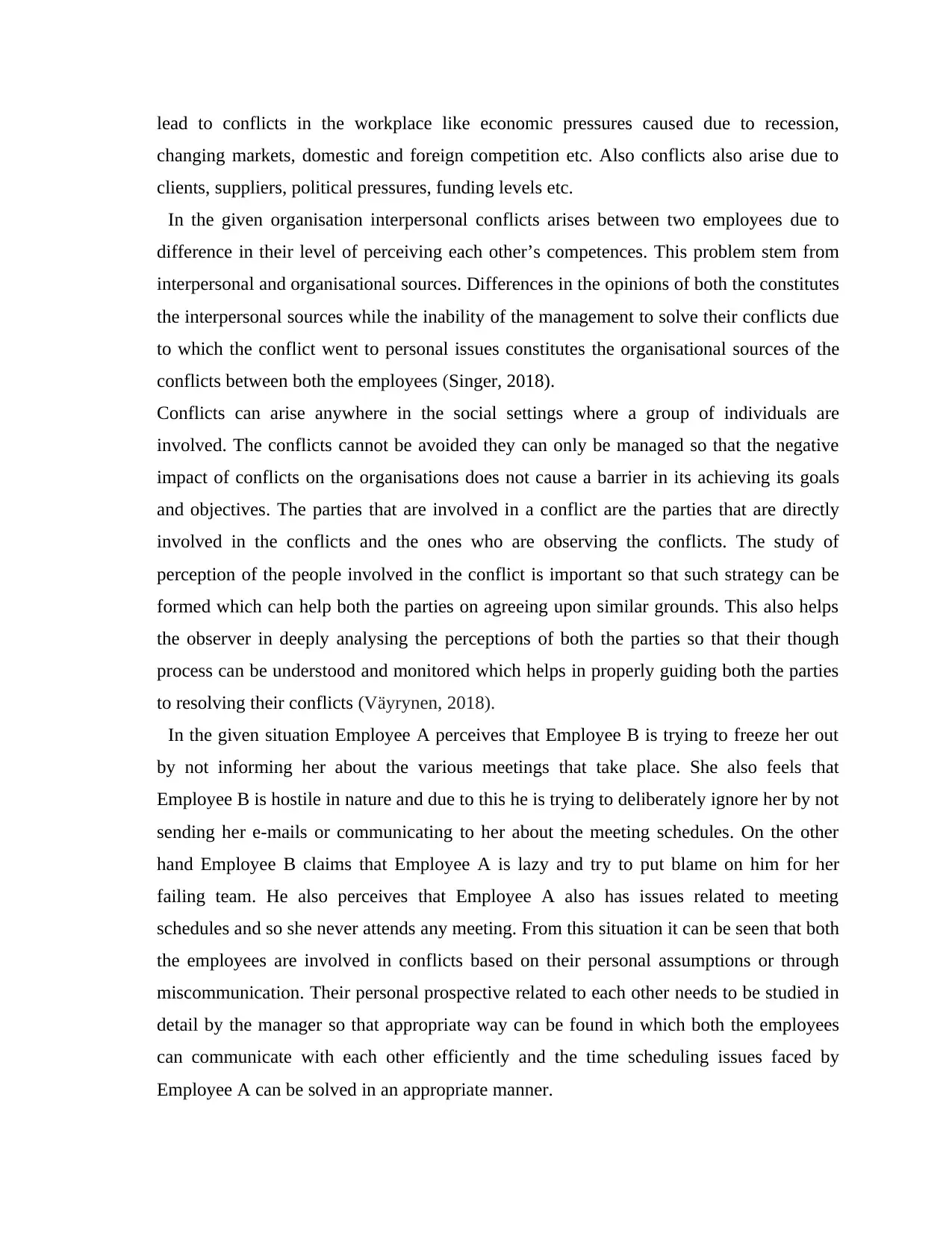
lead to conflicts in the workplace like economic pressures caused due to recession,
changing markets, domestic and foreign competition etc. Also conflicts also arise due to
clients, suppliers, political pressures, funding levels etc.
In the given organisation interpersonal conflicts arises between two employees due to
difference in their level of perceiving each other’s competences. This problem stem from
interpersonal and organisational sources. Differences in the opinions of both the constitutes
the interpersonal sources while the inability of the management to solve their conflicts due
to which the conflict went to personal issues constitutes the organisational sources of the
conflicts between both the employees (Singer, 2018).
Conflicts can arise anywhere in the social settings where a group of individuals are
involved. The conflicts cannot be avoided they can only be managed so that the negative
impact of conflicts on the organisations does not cause a barrier in its achieving its goals
and objectives. The parties that are involved in a conflict are the parties that are directly
involved in the conflicts and the ones who are observing the conflicts. The study of
perception of the people involved in the conflict is important so that such strategy can be
formed which can help both the parties on agreeing upon similar grounds. This also helps
the observer in deeply analysing the perceptions of both the parties so that their though
process can be understood and monitored which helps in properly guiding both the parties
to resolving their conflicts (Väyrynen, 2018).
In the given situation Employee A perceives that Employee B is trying to freeze her out
by not informing her about the various meetings that take place. She also feels that
Employee B is hostile in nature and due to this he is trying to deliberately ignore her by not
sending her e-mails or communicating to her about the meeting schedules. On the other
hand Employee B claims that Employee A is lazy and try to put blame on him for her
failing team. He also perceives that Employee A also has issues related to meeting
schedules and so she never attends any meeting. From this situation it can be seen that both
the employees are involved in conflicts based on their personal assumptions or through
miscommunication. Their personal prospective related to each other needs to be studied in
detail by the manager so that appropriate way can be found in which both the employees
can communicate with each other efficiently and the time scheduling issues faced by
Employee A can be solved in an appropriate manner.
changing markets, domestic and foreign competition etc. Also conflicts also arise due to
clients, suppliers, political pressures, funding levels etc.
In the given organisation interpersonal conflicts arises between two employees due to
difference in their level of perceiving each other’s competences. This problem stem from
interpersonal and organisational sources. Differences in the opinions of both the constitutes
the interpersonal sources while the inability of the management to solve their conflicts due
to which the conflict went to personal issues constitutes the organisational sources of the
conflicts between both the employees (Singer, 2018).
Conflicts can arise anywhere in the social settings where a group of individuals are
involved. The conflicts cannot be avoided they can only be managed so that the negative
impact of conflicts on the organisations does not cause a barrier in its achieving its goals
and objectives. The parties that are involved in a conflict are the parties that are directly
involved in the conflicts and the ones who are observing the conflicts. The study of
perception of the people involved in the conflict is important so that such strategy can be
formed which can help both the parties on agreeing upon similar grounds. This also helps
the observer in deeply analysing the perceptions of both the parties so that their though
process can be understood and monitored which helps in properly guiding both the parties
to resolving their conflicts (Väyrynen, 2018).
In the given situation Employee A perceives that Employee B is trying to freeze her out
by not informing her about the various meetings that take place. She also feels that
Employee B is hostile in nature and due to this he is trying to deliberately ignore her by not
sending her e-mails or communicating to her about the meeting schedules. On the other
hand Employee B claims that Employee A is lazy and try to put blame on him for her
failing team. He also perceives that Employee A also has issues related to meeting
schedules and so she never attends any meeting. From this situation it can be seen that both
the employees are involved in conflicts based on their personal assumptions or through
miscommunication. Their personal prospective related to each other needs to be studied in
detail by the manager so that appropriate way can be found in which both the employees
can communicate with each other efficiently and the time scheduling issues faced by
Employee A can be solved in an appropriate manner.
Paraphrase This Document
Need a fresh take? Get an instant paraphrase of this document with our AI Paraphraser
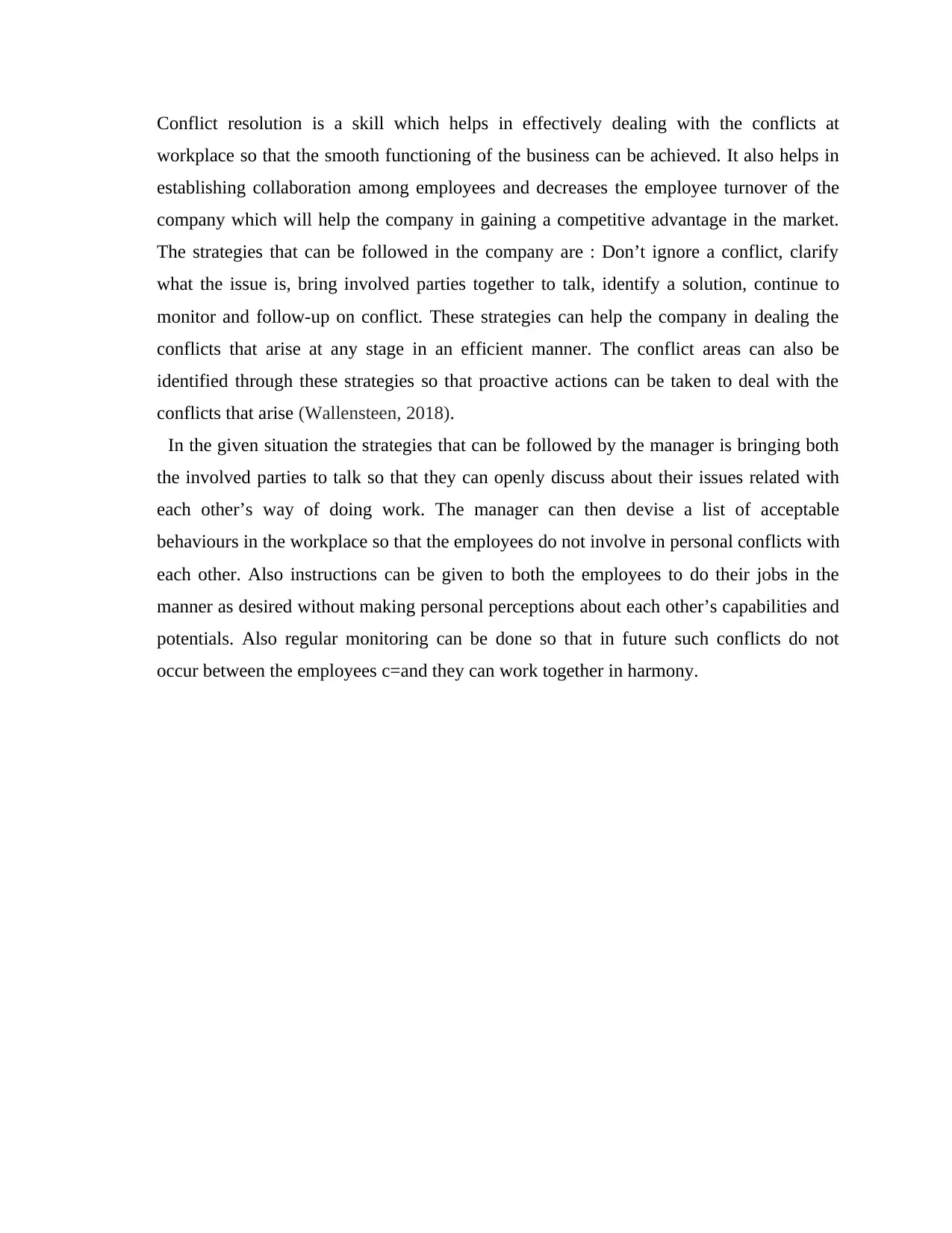
Conflict resolution is a skill which helps in effectively dealing with the conflicts at
workplace so that the smooth functioning of the business can be achieved. It also helps in
establishing collaboration among employees and decreases the employee turnover of the
company which will help the company in gaining a competitive advantage in the market.
The strategies that can be followed in the company are : Don’t ignore a conflict, clarify
what the issue is, bring involved parties together to talk, identify a solution, continue to
monitor and follow-up on conflict. These strategies can help the company in dealing the
conflicts that arise at any stage in an efficient manner. The conflict areas can also be
identified through these strategies so that proactive actions can be taken to deal with the
conflicts that arise (Wallensteen, 2018).
In the given situation the strategies that can be followed by the manager is bringing both
the involved parties to talk so that they can openly discuss about their issues related with
each other’s way of doing work. The manager can then devise a list of acceptable
behaviours in the workplace so that the employees do not involve in personal conflicts with
each other. Also instructions can be given to both the employees to do their jobs in the
manner as desired without making personal perceptions about each other’s capabilities and
potentials. Also regular monitoring can be done so that in future such conflicts do not
occur between the employees c=and they can work together in harmony.
workplace so that the smooth functioning of the business can be achieved. It also helps in
establishing collaboration among employees and decreases the employee turnover of the
company which will help the company in gaining a competitive advantage in the market.
The strategies that can be followed in the company are : Don’t ignore a conflict, clarify
what the issue is, bring involved parties together to talk, identify a solution, continue to
monitor and follow-up on conflict. These strategies can help the company in dealing the
conflicts that arise at any stage in an efficient manner. The conflict areas can also be
identified through these strategies so that proactive actions can be taken to deal with the
conflicts that arise (Wallensteen, 2018).
In the given situation the strategies that can be followed by the manager is bringing both
the involved parties to talk so that they can openly discuss about their issues related with
each other’s way of doing work. The manager can then devise a list of acceptable
behaviours in the workplace so that the employees do not involve in personal conflicts with
each other. Also instructions can be given to both the employees to do their jobs in the
manner as desired without making personal perceptions about each other’s capabilities and
potentials. Also regular monitoring can be done so that in future such conflicts do not
occur between the employees c=and they can work together in harmony.
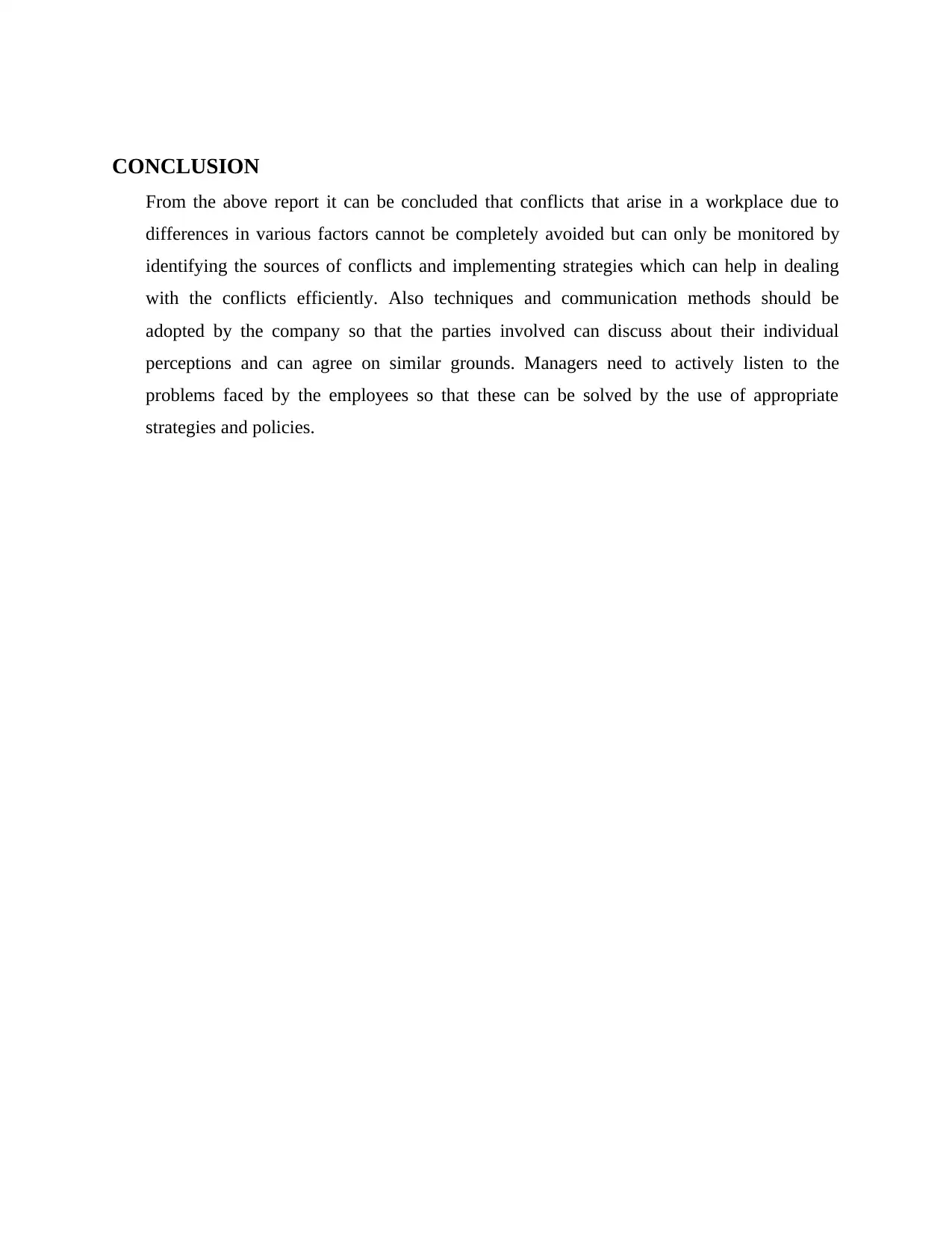
CONCLUSION
From the above report it can be concluded that conflicts that arise in a workplace due to
differences in various factors cannot be completely avoided but can only be monitored by
identifying the sources of conflicts and implementing strategies which can help in dealing
with the conflicts efficiently. Also techniques and communication methods should be
adopted by the company so that the parties involved can discuss about their individual
perceptions and can agree on similar grounds. Managers need to actively listen to the
problems faced by the employees so that these can be solved by the use of appropriate
strategies and policies.
From the above report it can be concluded that conflicts that arise in a workplace due to
differences in various factors cannot be completely avoided but can only be monitored by
identifying the sources of conflicts and implementing strategies which can help in dealing
with the conflicts efficiently. Also techniques and communication methods should be
adopted by the company so that the parties involved can discuss about their individual
perceptions and can agree on similar grounds. Managers need to actively listen to the
problems faced by the employees so that these can be solved by the use of appropriate
strategies and policies.
⊘ This is a preview!⊘
Do you want full access?
Subscribe today to unlock all pages.

Trusted by 1+ million students worldwide
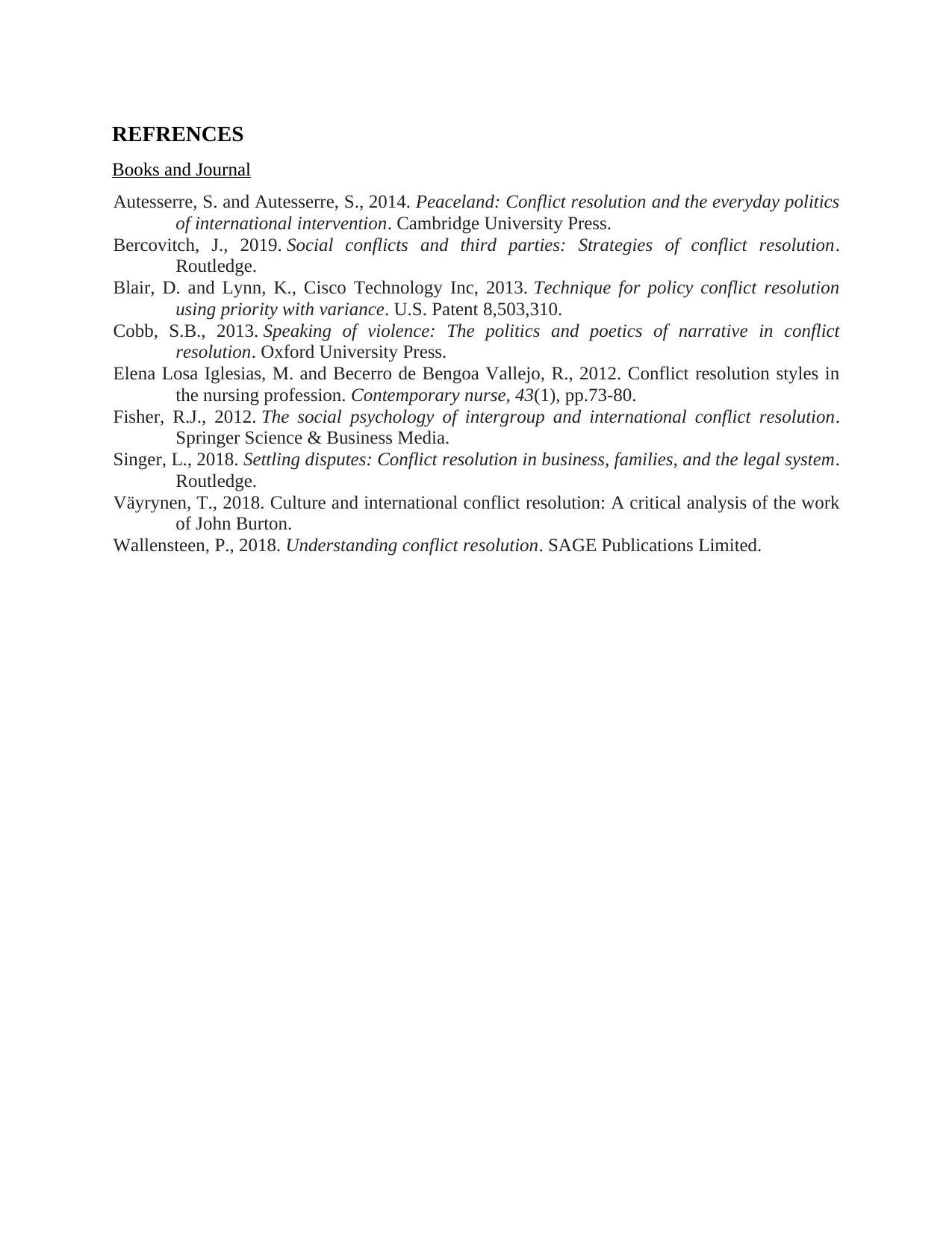
REFRENCES
Books and Journal
Autesserre, S. and Autesserre, S., 2014. Peaceland: Conflict resolution and the everyday politics
of international intervention. Cambridge University Press.
Bercovitch, J., 2019. Social conflicts and third parties: Strategies of conflict resolution.
Routledge.
Blair, D. and Lynn, K., Cisco Technology Inc, 2013. Technique for policy conflict resolution
using priority with variance. U.S. Patent 8,503,310.
Cobb, S.B., 2013. Speaking of violence: The politics and poetics of narrative in conflict
resolution. Oxford University Press.
Elena Losa Iglesias, M. and Becerro de Bengoa Vallejo, R., 2012. Conflict resolution styles in
the nursing profession. Contemporary nurse, 43(1), pp.73-80.
Fisher, R.J., 2012. The social psychology of intergroup and international conflict resolution.
Springer Science & Business Media.
Singer, L., 2018. Settling disputes: Conflict resolution in business, families, and the legal system.
Routledge.
Väyrynen, T., 2018. Culture and international conflict resolution: A critical analysis of the work
of John Burton.
Wallensteen, P., 2018. Understanding conflict resolution. SAGE Publications Limited.
Books and Journal
Autesserre, S. and Autesserre, S., 2014. Peaceland: Conflict resolution and the everyday politics
of international intervention. Cambridge University Press.
Bercovitch, J., 2019. Social conflicts and third parties: Strategies of conflict resolution.
Routledge.
Blair, D. and Lynn, K., Cisco Technology Inc, 2013. Technique for policy conflict resolution
using priority with variance. U.S. Patent 8,503,310.
Cobb, S.B., 2013. Speaking of violence: The politics and poetics of narrative in conflict
resolution. Oxford University Press.
Elena Losa Iglesias, M. and Becerro de Bengoa Vallejo, R., 2012. Conflict resolution styles in
the nursing profession. Contemporary nurse, 43(1), pp.73-80.
Fisher, R.J., 2012. The social psychology of intergroup and international conflict resolution.
Springer Science & Business Media.
Singer, L., 2018. Settling disputes: Conflict resolution in business, families, and the legal system.
Routledge.
Väyrynen, T., 2018. Culture and international conflict resolution: A critical analysis of the work
of John Burton.
Wallensteen, P., 2018. Understanding conflict resolution. SAGE Publications Limited.
1 out of 10
Related Documents
Your All-in-One AI-Powered Toolkit for Academic Success.
+13062052269
info@desklib.com
Available 24*7 on WhatsApp / Email
![[object Object]](/_next/static/media/star-bottom.7253800d.svg)
Unlock your academic potential
Copyright © 2020–2025 A2Z Services. All Rights Reserved. Developed and managed by ZUCOL.





